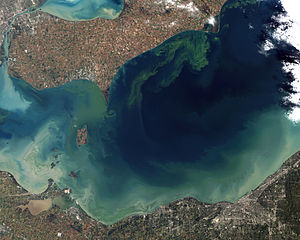
Image captured by the Landsat-5 satellite. Data provided courtesy of the United States Geological Survey
Written by
Kristina Smith
Watchdog/enterprise reporter
The way scientists forecast how bad the toxic algae on Lake Erie’s Western Basin could be in a given year is changing, and scientists hope it will be more accurate and understandable.
For the past two years, scientists from the National Oceanic and Atmospheric Administration and from Ohio colleges and universities have released their forecast for how bad the harmful algal blooms will be.
The blooms of blue-green algae can produce a toxin, called microcystin, that is a liver toxin and can cause gastrointestinal illness and skin irritation in people. The algae also threatens the area’s tourism industry and causes concern among water plant operators who need to make sure the toxin is removed from drinking water.
Scientists will meet July 10 at The Ohio State University’s Stone Laboratory on Gibraltar Island near Put-in-Bay to release their predictions for this summer.
The difference this year is that they’ll make two forecasts, one on July 10 and another in August, said Jeff Reutter, director of The Ohio State University’s Ohio Sea Grant College Program and Stone Laboratory.
“The one in August will be more accurate,” he said. “We’ll have more information from July.
“It’s very similar to what NOAA does with hurricanes.”
They’d also like to put a number system on how bad they expect the blooms to be, with one being good and 10 being very bad.
The worst year on record was 2011 — where blooms were so thick anglers reported their boats slowed down as they drove through the algae —and that would be considered a 10, he said.
A year that might be a one would be 2002, the first year the blooms re-emerged as a Lake Erie issue after they were a problem in the 1970s.
“That might help people if they have that number,” Reutter said.
Last year, NOAA predicted a “significant bloom” they expected to be worse than the mild 2012 bloom but one-fifth of the massive 2011 bloom.
“Last year’s bloom we underestimated,” Reutter said. “It was worse than we forecast.”
The blooms are fueled by phosphorous loading that comes mainly from farm fertilizer and sewer plants, among other sources. Heavy spring rains can contribute to the amount of runoff.
Given the heavy amount of spring rain this year, Reutter said earlier this month he expects an average-sized bloom.
“That’s still as much as I’d feel comfortable in saying,” he said Tuesday.
A harmful algal bloom already has been spotted this year in the Sandusky Bay, he said. This bloom is a different type of blue-green algae, called planktothrix, than the microcystis normally found on Lake Erie.
Planktothrix doesn’t rise to the top of the water, but it turns the water green and also produces the toxin microcystin.
“A lot of times Sandusky Bay gets it very, very early,” he said.
Blooms have not been found anywhere else in the lake yet. Usually, they do not show up in other parts of the lake until late summer.
http://www.portclintonnewsherald.com/article/20140617/NEWS01/306170021
